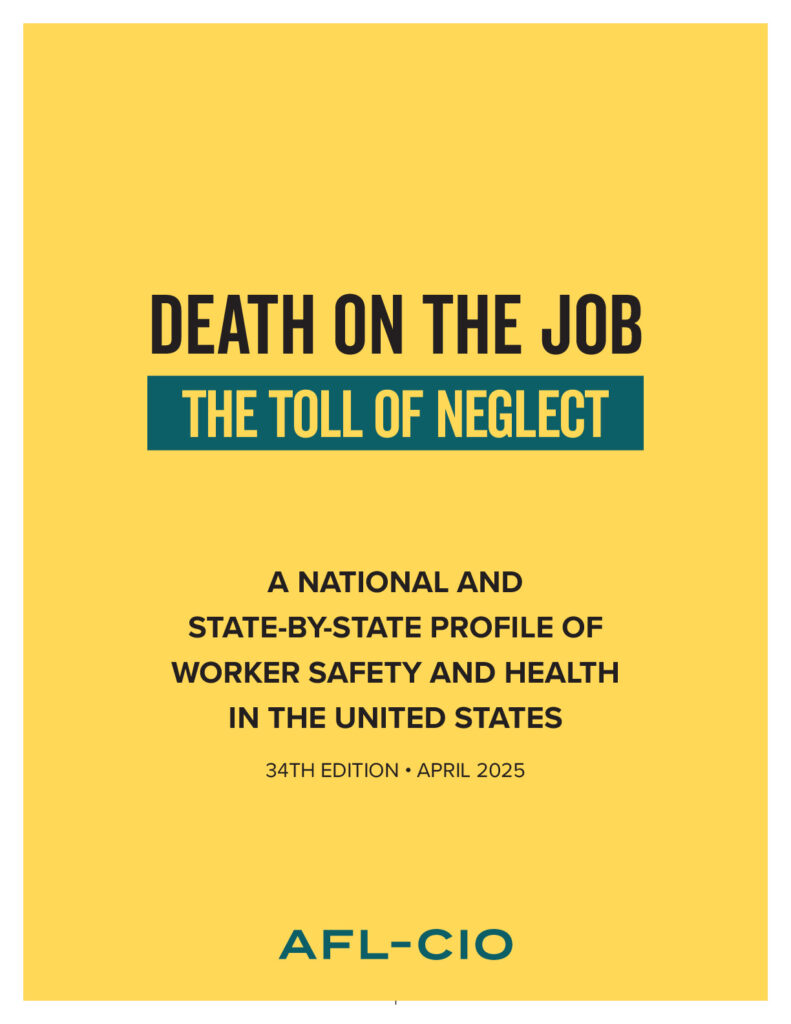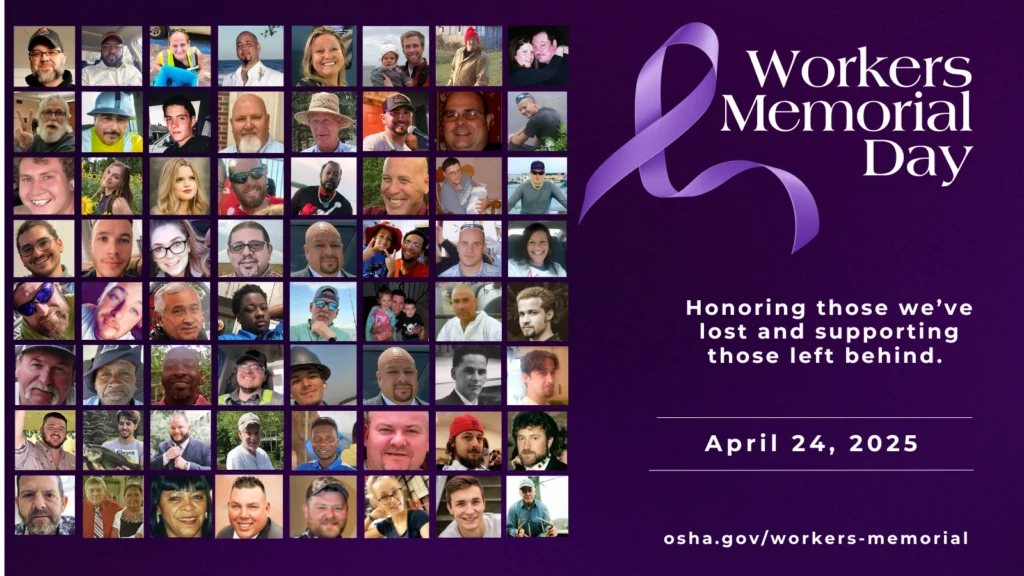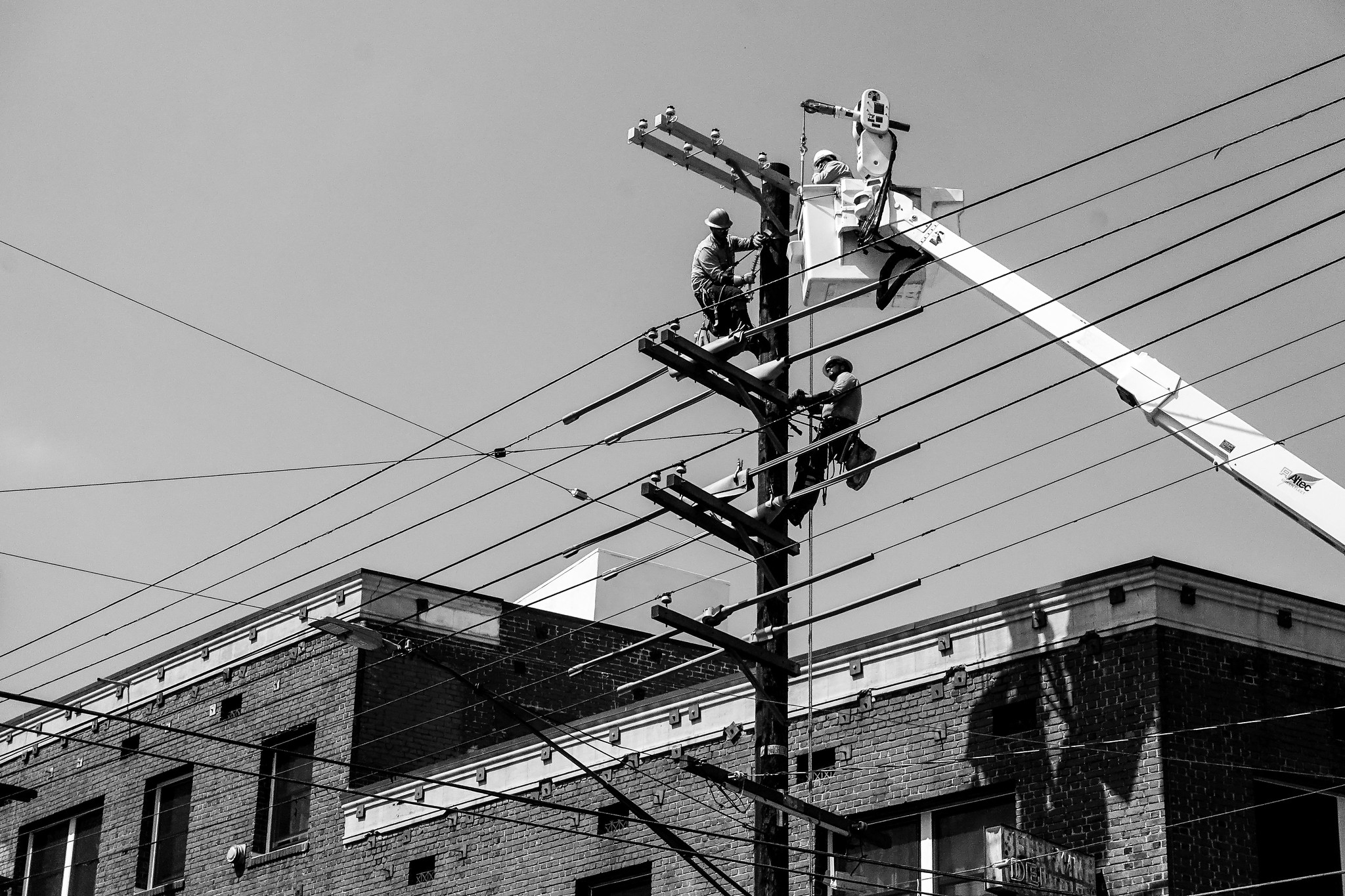Workers Memorial Day is April 28, and right on schedule, the AFL-CIO has released its annual Death on the Job report — the bible of workplace safety and health. This is the 34th edition of DOTJ, as it’s affectionately called. And as expected, the report delivers a well-deserved condemnation of President Trump’s anti-worker, anti-health & safety agenda, along with the facts you need to fight against the widespread DOGE-MAGA attacks on America’s working people.
As the report documents, “President Trump’s first 100 days of his second administration have not only attacked Biden administration progress, but confirmed his anti-worker, pro-business philosophy.” Elon Musk’s DOGE has launched a full-scale attack on workers by eliminating entire government agencies, fired tens of thousands of federal workers and removed union representation from hundreds of thousands. All under the guise of eliminating waste, fraud and abuse, although Musk and his DOGE-Bros have identified no significant waste, fraud or abuse to eliminate.
Trump’s ongoing attacks on workplace safety and health will ultimately doom countless American workers to preventable illnesses, injuries and death:
The Trump administration and DOGE have focused on totally decimating the fabric of what makes government protections work for people through attacks on job safety, public health, union rights and the independence of federal agencies. Attacks on federal workers aim to decimate the fairest employer in the country; it is not a coincidence, and it is not efficient. There is no misunderstanding among workers and unions that state and local governments and the private sector will be next on the chopping block. In the most poignant and direct attack on worker safety, DOGE functionally eliminated the National Institute for Occupational Safety and Health (NIOSH), the only worker safety and health research agency. Worker safety is not a priority for this administration
Just the Facts

The most valuable part of the annual Death on the Job report is the facts and data it contains: Everything you ever wanted to know about workplace safety and health in this country, conveniently broken down by state. The report is full of informational graphs and charts covering every fact and data point that you, other activists, workers, government officials, employers, researchers and reporters need to know.
Need the latest data on workplace injuries, illnesses and deaths? Need to know which groups, genders, ages, nationalities, industries or occupations are most at risk? How well funded are OSHA and MSHA and to what extent are they able to fulfill the mission that Congress gave them? Is OSHA’s budget adequate and how has it changed over the decades? How are OSHA and MSHA addressing new, unregulated hazards like heat, workplace violence and infectious diseases? What is the impact on workers of the destruction of NIOSH? How does your state rate in terms of injuries and deaths, as well as budget and staff devoted to enforcing workplace safety and health protections?
It’s all in DOTJ.
The basic facts are depressing enough. 5,283 workers were killed on the job in the United States last year (many of whom are chronicled in the Weekly Toll.)
But those deaths only scratch the surface of workplace death. Another estimated 135,304 workers died from occupational diseases caused by chemicals, infectious diseases and other hazardous substances.
Like other societal problems, the costs of workplace hazards are not shared equally: Workers of color die on the job at a higher rate than white workers
And like other societal problems, the costs of workplace hazards are not shared equally: Workers of color die on the job at a higher rate than white workers: Black and Latino worker job fatality rates are disproportionately high compared with all other workers and are continuing to increase. Latino workers die on the job at a 26% higher rate than the national average.
The report also points out the inadequacy of OSHA’s current resources: There are 1,802 inspectors (768 federal and 1,034 state) to inspect the 11.8 million workplaces under OSHA’s jurisdiction which covers 161 million workers. Meanwhile, as the economy grows, federal OSHA has 85 fewer inspectors than in FY 2023— only enough to now inspect workplaces once every 185 years. (State OSHA plans have 12 additional inspectors compared with FY 2023.)
OSHA spends only a paltry $3.92 a year to protect each worker in the country.
This comes to one inspector for every 84,937 workers. In 1980, OSHA had one inspector per 24,871 workers. Even as recently as 2016, OSHA had one inspector for every 65,228 workers.
Meanwhile, penalties remain far too low. Although the maximum penalty for a serious OSHA violation is $16,550, the average penalty for a serious violation was only $4,083 for federal OSHA and $2,580 for OSHA state plans.
The cost of job injuries and illnesses is enormous, estimated at $174 billion to $348 billion a year. And that’s an underestimate. Yet OSHA’s current budget is only $632 million. OSHA spends only a paltry $3.92 a year to protect each worker in the country.
In a normal, rational world, a Presidential administration truly focused on reducing “waste, fraud and abuse” would heavily invest in workplace safety. Instead, the Trump administration has eliminated NIOSH and we don’t know yet what lies in store for OSHA or MSHA.
Where Are We Going?
During his confirmation hearing, DOL Deputy Secretary Keith Sonderling promised Democratic Senators that he would ensure that DOL agencies are able to operate with the appropriate funding, and he will work with Congress and the White House to ensure that every DOL agency has the resources they need.
If Sonderling studies DOTJ and if he was telling the truth, he and DOL Secretary Lori Chavez-DeRemer will recommend to Trump and Congress a major increase in OSHA’s budget and the full restoration of NIOSH. Given that this is the Trump administration, however, and none of his nominees have told the truth during their confirmation hearings, OSHA will be lucky to survive, much less expand.
For those who are really interested in protecting workers’ lives, there is much to be done, according to the report: Congress needs to increase OSHA’s budget and pass legislation that would strengthen OSHA and mine safety laws, as well as laws that would require OSHA to issue standards to protect workers against heat and workplace violence.
Job safety agencies like OSHA, MSHA and the EPA need to be fully funded and empowered to enforce the laws protecting workers, vigorously defend workers against retaliation, preserve and expand workers’ rights and expand protections by issuing strong standards, especially covering heat, workplace violence and infectious diseases. Workers, public health advocates and worker allies in Congress need to hold OSHA and MSHA to their missions.
Maintaining even a semblance of the missions that worker protection agencies were given will require a herculean effort by workers, unions, worker and public health advocates, public health advocates and everyone in this country who cares about the lives of America’s working people.
All this seems like pie-in-the-sky while the agencies that Congress created to protect workers are literally on the chopping block. We still have not seen what the Trump regime has planned for OSHA and negotiations over the FY 2026 budget will begin soon. Maintaining even a semblance of the missions that worker protection agencies were given will require a herculean effort by workers, unions, worker and public health advocates, public health advocates and everyone in this country who cares about the lives of America’s working people.
It’s literally a matter of life and death.
Workers Memorial Day at OSHA
 Workers Memorial Day is April 28, and events are being held across this country and around the world. The overall theme, as always, was inspired by labor organizer Mother Jones: “Pray for the Dead, and Fight Like Hell for the Living.”
Workers Memorial Day is April 28, and events are being held across this country and around the world. The overall theme, as always, was inspired by labor organizer Mother Jones: “Pray for the Dead, and Fight Like Hell for the Living.”
Meanwhile, in the middle of this destructive, anti-worker chaos that we’re experiencing daily, OSHA is holding a Workers Memorial Day commemoration tomorrow at the Department of Labor. The theme of this year’s commemoration is “Honoring Those We’ve Lost and Supporting Those Left Behind.” As with previous years, families of fallen workers will attend and many will speak about their tragic loss. Normally I attend these events at DOL. I always find them quite moving, and the families inspiring. I always cry.
But I can’t stomach it this year. The hypocrisy is more than I can take.
“Honoring Those We’ve Lost and Supporting Those Left Behind” is a worthy sentiment. Those we’ve lost should be honored and their families, friends and co-workers need our support. I have known many of the family members for many years. One of my first actions at OSHA was to replace the photos of OSHA’s executive staff in the conference room with photos of fallen workers that their families provided.
An administration that has eliminated NIOSH — and is on the verge of severely weakening OSHA and MSHA — is not an administration that honors lost workers.
But an administration that has eliminated NIOSH — and is on the verge of severely weakening OSHA and MSHA — is not an administration that honors lost workers. It does not honor or support those left behind. And it does not really care how many more workers we will lose and how many more families will suffer due to their actions.
I have enormous admiration for those who work at OSHA and MSHA, and especially those who worked to organize this event. They are some of the hardest working, most dedicated and compassionate people you will ever meet.
But this year, my stomach just can’t take it.
_______________
You can download the entire Death on the Job report here. Put it on your (virtual) bookshelf, bookmark it and keep it handy. If you’re working to protect workers’ safety and health, you’ll be consulting it constantly

“If Sonderling studies DOTJ and if he was telling the truth, he and DOL Secretary Lori Chavez-DeRemer will recommend to Trump and Congress a major increase in OSHA’s budget and the full restoration of NIOSH. Given that this is the Trump administration, however, and none of his nominees have told the truth during their confirmation hearings, OSHA will be lucky to survive, much less expand.” Jordan Barab, this statement is not true and is only divisional. In reading your diatribe, its clear what you hate and that’s your call and totally fine. However, having spent 41 years and continuing to protect workforces, its also an equal concern how you and Dr. David Michaels are now whining about things. Let’s work together and create a tone that helps build occupational safety and health, not tear it down. Your writings are too negative and at times, not accurate. Most of what you say is something I can support but let’s keep it focused on what we can do, not on the hatred our stomachs endure.
Thanks for your comment Chuck, but I’m not exactly sure what your issue is. True, I may have exaggerated somewhat: I’m sure some things that some nominees said were accurate, but I don’t think I was far off. In fact, given this Administration’s total destruction of NIOSH, I’d say I’ve been understating the damage. And I don’t see how accurately describing the chaos that the Trump administration has brought down on this nation’s workers can be characterized as “whining.” As far as “working together,” sure, happy to, with those who are willing. But this administration has shown no indication — zero — through its destructive and illegal actions that it is willing to work with anyone — even Republicans in Congress. Have we seen any administration official go to OSHA offering to work together to make the agency more effective, or asking what kind of budget OSHA needs to do its job effectively?